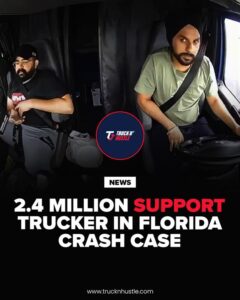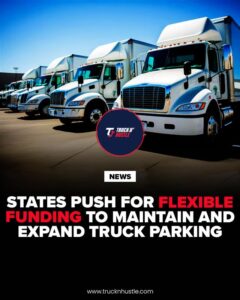For owner-operators, small fleet owners, and budding business owners, the decision to borrow money is frequently fraught with uncertainty and anxiety. Is taking out a loan the first step to financial ruin or the secret to achieving growth?
Ami Kassar, Founder & CEO of MultiFunding, LLC, deconstructs the realities of borrowing money for small business owners and trucking companies in an impactful interview on Truck N’ Hustle. Ami offers the unvarnished truth about what lenders genuinely care about and how to steer clear of the pitfalls that lead to the demise of so many companies, having spent decades assisting entrepreneurs in obtaining SBA loans, business lines of credit, and working capital financing.
Here is a comprehensive summary of his observations, which are geared toward trucking professionals facing growing expenses, difficulties with compliance, and the need for more intelligent growth.
Why Borrowing Money Isn’t Just About Interest Rates (The Real Cost Truckers Miss)
What is one of the major concerns for most business owners? It’s interest rates. Hours will be spent debating whether an SBA loan is 9.5% or 10%. But that’s the wrong focus, says Ami Kassar.
The actual query is: How much does the loan cost you every month?
1. If your cash flow is erratic, a $12,000 auto loan with 0% interest for a year would mean $1,000 in payments each month.
2. Despite appearing “more expensive,” a $12,000 loan with a 5% interest rate spread over five years is manageable at $250 per month.
This is an important lesson for trucking companies. Seasonality affects freight, diesel prices change, and repairs are unplanned. Maintaining a manageable monthly payment is more important for your survival than having the lowest rate.
Cash Flow Is King: The #1 Factor Lenders Really Care About
Cash is reality, profit is sanity, and revenue is vanity.
Ami Kassar lives by this motto. Even if your trucking company makes $4 million, lenders won’t care if your net profit is insufficient to pay off your debt. The most important metric that lenders look at is cash flow management.
1. A Debt Service Coverage Ratio (DSCR) of 1.25 or higher is indicative of healthy borrowers. This indicates that for every $1 in debt payments, you make $1.25 in income.
2. Even seasonal companies (such as freight carriers) can be eligible if they exhibit consistent cash cycles.
3. Truckers who depend on invoice factoring or bill juggling frequently have trouble demonstrating consistent cash flow.
In summary, make sure your books are in order and demonstrate steady profitability before applying for trucking business loans.
The Hidden Pitfalls Of Business Loans: What Lenders Don’t Always Tell You
Not all lenders clearly disclose their terms. Ami cautions business owners against using alternative lending providers that guarantee “fast approvals” within 24 to 48 hours.
Typical traps consist of:
1. Last-minute adjustments to interest rates or collateral.
2. You are locked into expensive loans with hidden prepayment penalties.
3. “Stacked loans” that put you on a never-ending debt cycle with payments due every day or every week.
This is particularly risky when trucking. These loans are often taken out by owner-operators for repairs or fuel, which have 200% annual percentage rates.
Ami’s main piece of advice: If a loan seems too good to be true, it most likely is. Always request in writing, from lenders, a list of all costs, penalties, and collateral requirements before signing.
Monthly Payments Vs. Interest Rates: How To Avoid Overborrowing In Trucking
When evaluating a loan, truckers need to think about their monthly responsibilities, not just the annualized interest rate.
1. When business owners are approved for more loans than they require, this is known as overborrowing. Even if banks approve $500,000, the larger loan could destroy you if your company can only support $250,000.
2. When freight companies grow overnight from 10 to 50 loads per week, they frequently fail because their fixed costs increase more quickly than their operational capacity.
Ami’s general rule is to borrow for the upcoming year’s growth rather than for an impractical five-year plan.
The Truth About Personal Guarantees, Liens, And Default Terms
When applying for bank financing or SBA loans, most entrepreneurs are unaware of the personal risk they are taking.
The truth is as follows:
1. Lenders frequently demand a lien on your property if you own a home with equity.
2. Your assets and personal credit may be in jeopardy if your business fails.
3. A personal guarantee holds you legally liable for repayment even if you split your business entity (corporation or LLC).
For truckers, this implies that your business loan may be linked to your home, savings, or retirement assets.
Why Some Trucking Businesses Fail After Borrowing Money (And How To Avoid It)
Approximately 1% of SBA loans result in default, according to Ami Kassar. However, defaults typically result from the same errors:
1. Taking out too large a loan too soon.
2. Not preparing for downturns (such as COVID, spikes in diesel, or changes in regulations).
3. Extending routes or fleets without providing a stable cash flow.
Ways to prevent failure:
1. Only take out loans that are justified by your earnings.
2. Invest in your company’s cash reserves, or retained earnings.
3. Scaling too quickly can ruin even profitable carriers, so be realistic about your growth.
Prepayment Penalties Explained: How Paying Back Early Can Still Cost You
Many trucking business owners believe they can save money by repaying their loans early. However, there are prepayment penalties associated with some loans.
1. Loans under 15 years are exempt from penalties under SBA 7(a).
2. Prepayment penalties range from three to five years for SBA 504 loans and certain commercial loans.
3. Predatory lenders frequently include unstated costs in exchange for early repayment.
Always wonder what would happen if the loan were paid off sooner. Determine whether refinancing makes sense if there is a penalty.
Borrowing For Growth: How Much Can You Really Qualify For?
Ami Kassar emphasizes that lenders base loans on cash flow and profitability rather than gross revenue.
1. The maximum amount of an SBA loan is $5 million per borrower.
2. Between $40 and $50 billion in small business loans were approved nationwide by the SBA in 2024.
3. If they can demonstrate cash flow, truckers and small fleet owners may be eligible for loans as small as $50,000 to $150,000 for new businesses or multi-million dollar loans for fleet expansion.
Before applying, concentrate on streamlining operations if your profit margins are narrow.
Building The Right Team Around Your Weaknesses Before You Borrow
One of the most important lessons Ami taught was that entrepreneurs can’t do it all alone.
There is an “elephant in the room” with every loan application, whether it be a high turnover rate, inadequate compliance systems, or bad bookkeeping. The top borrowers don’t conceal it; instead, they forge a team around it.
1. If your finances are disorganized, hire a bookkeeper or a CFO service.
2. Collaborate with safety and compliance professionals to meet requirements.
3. To maintain revenue, collaborate with a trustworthy freight broker or dispatcher.
Important realization: Lenders have greater faith in business owners who acknowledge their shortcomings and demonstrate that they are putting support networks in place.
What Makes A “Good Borrower” In The Eyes Of A Lender
Ami Kassar claims that strong borrowers have three characteristics in common:
1. Honesty: Not exaggerating revenue or concealing factoring debt.
2. Preparedness: This includes having a well-organized financial plan, current bank statements, and a well-defined business strategy.
3. Coachability: This is the capacity to hear the harsh realities of what they can reasonably afford.
Delays, withholding information, and arguments with lenders frequently result in poor or nonexistent deals for borrowers.
The Step-By-Step Process Of Securing A Business Loan The Smart Way
This is how things work at Ami’s company, MultiFunding:
1. Recognize the Objective: Is it refinancing, fleet expansion, or working capital?
2. Gather Full Financials: This is done taking into account both strengths and weaknesses.
3. Match with the Right Lender: Choose the correct lender because not all SBA lenders are made equal. Only about 100 of the 1,400+ in the US regularly do good deals.
4. Negotiate Terms Transparently: Transparency in terms of negotiation fosters trust and expedites approvals.
Better rates, fewer rejections, and more time to manage their fleet are all benefits of this process for truckers.
Borrowing Money Is A Stage-By-Stage Journey, Not A Straight Line
Being an entrepreneur is not easy. According to Ami, it’s like walking a tightrope; some months you’ll feel like you’re doing well, and other months you’ll be fighting for your life.
For this reason, loans ought to be used gradually:
1. Take out a loan for the upcoming year, not for a distant goal.
2. Regularly reevaluate cash flow.
3. Be adaptable because every stage of your business will look different.
This way of thinking maintains the sustainability and scalability of trucking companies.
Conclusion
The main goal of borrowing money is to safeguard cash flow, manage debt sensibly, and expand gradually, not to find the best interest rate.
The reality of trucking business loans is straightforward, as Ami Kassar underlined:
1. Pay attention to monthly installments rather than just rates.
2. Tell lenders the truth.
3. Create a team based on your areas of weakness.
4. Only take out loans that you can afford.
Thanks to Truck N’ Hustle, trucking business owners can now learn how to turn debt from a burden into a tool for greater success.









